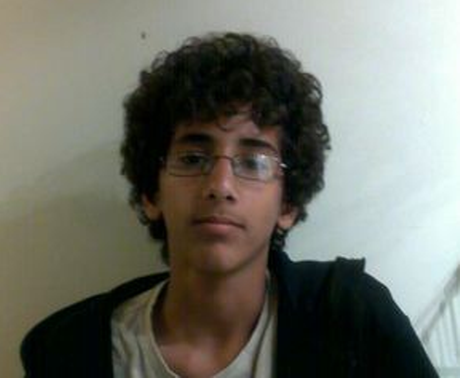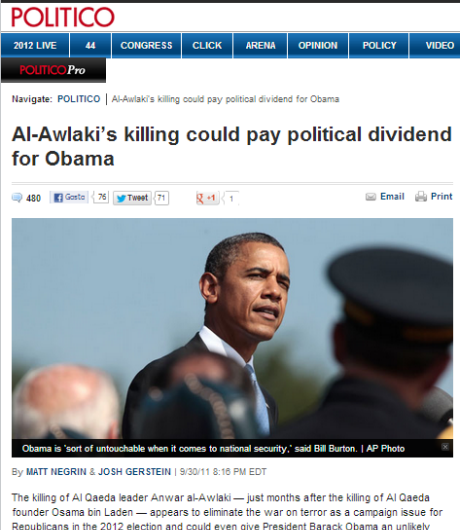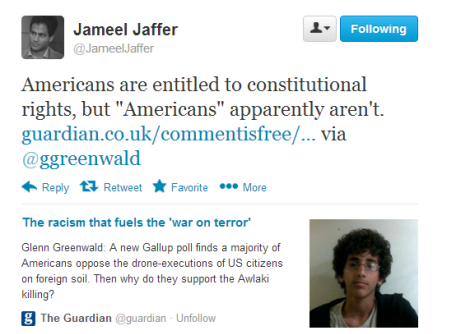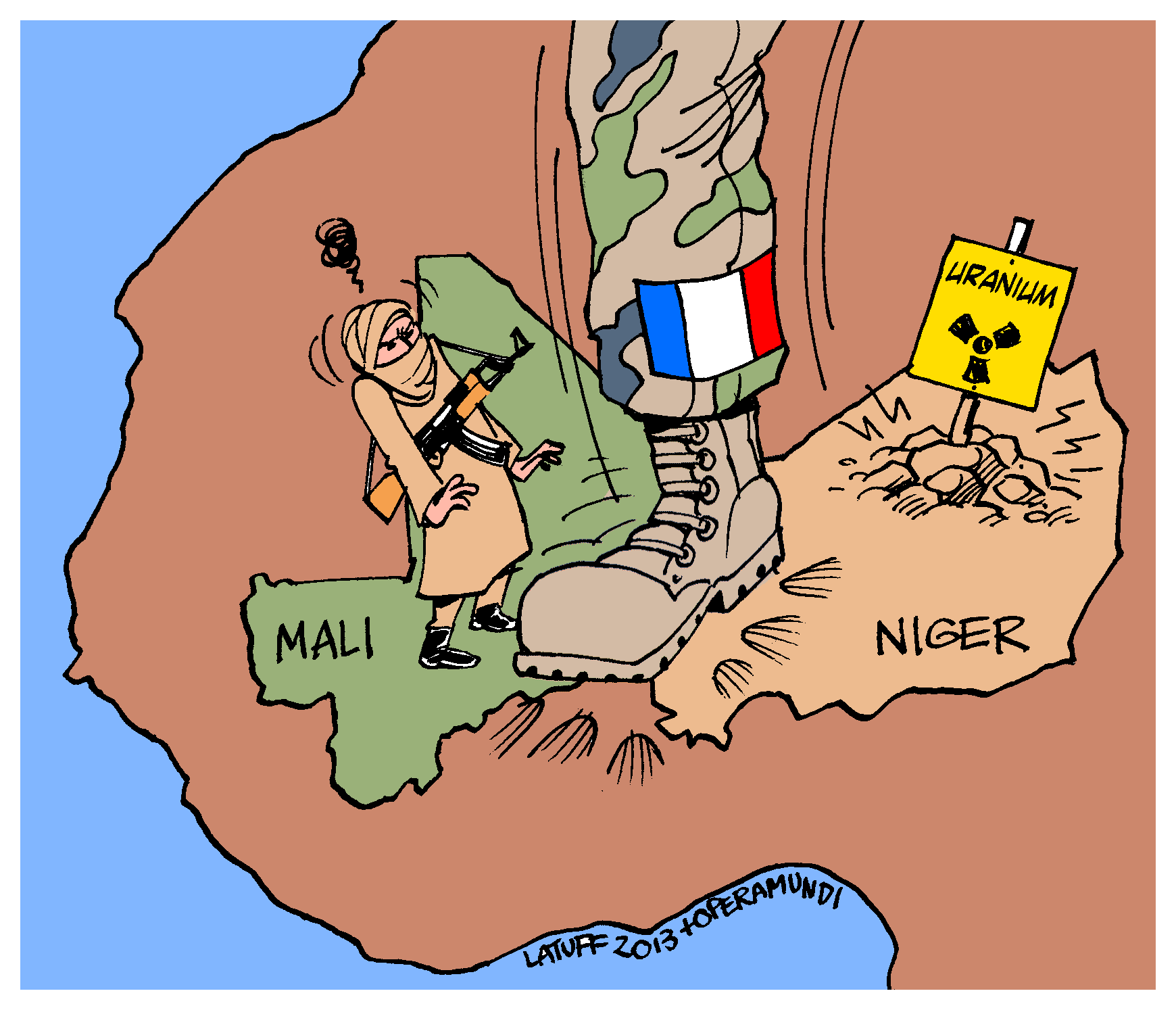
Tom Engelhardt writes in The Huffington Post
The communist enemy, with the “
world’s fourth largest military,” has been
trundling missiles around and threatening the United States with nuclear obliteration.
Guam, Hawaii,
Washington: all, it claims, are targetable. The coverage in the media has been hair-raising. The U.S. is
rushing an untested missile defense system to Guam, deploying missile-interceptor ships off the South Korean coast,
sending “nuclear capable” B-2 Stealth bombers thousands of miles on mock bombing runs,
pressuring China, and conducting large-scale
war games with its South Korean ally.
Only one small problem: there is as yet
little evidence that the enemy with a few nuclear weapons facing off (rhetorically at least) against an American arsenal of
4,650 of them has the
ability to miniaturize and mount even one on a missile, no less deliver it accurately, nor does it have a missile capable of reaching Hawaii or Washington, and I wouldn't count on Guam either.
It also happens to be a desperate country, one possibly
without enough fuel to fly a modern air force, whose people, on average, are
inches shorter than their southern neighbors thanks to decades of intermittent famine and malnutrition, and who are ruled by a bizarre three-generational family cult. If that other communist, Karl Marx, hadn’t once famously written that history repeats itself “first as tragedy, then as farce,” we would have had to invent the phrase for this very moment.
In the previous century, there were two devastating global wars, which left significant parts of the planet in ruins. There was also a "cold war" between two superpowers locked in a system of
mutual assured destruction (aptly acronymed as MAD) whose nuclear arsenals were capable of destroying the planet many times over. Had you woken up any morning in the years between
December 7, 1941, and
December 26, 1991, and been told that the leading international candidate for America's Public Enemy Number One was Kim Jong-un’s ramshackle, comic-opera regime in North Korea, you might have gotten down on your hands and knees and sent thanks to pagan gods.
The same would be true for the other candidates for that number one position since September 11, 2001: the original al-Qaeda (largely decimated), al-Qaeda in the Arabian Peninsula located in poverty-stricken areas of poverty-stricken Yemen, the Taliban in poverty-stricken Afghanistan, unnamed jihadis scattered across poverty-stricken areas of North Africa, or Iran, another rickety regional power run by not particularly adept theocrats.
All these years, we’ve been launching wars and pursuing a “global war on terror." We’ve poured money into national security as if there were no tomorrow. From
our police to
our borders, we’ve up-armored everywhere. We constantly hear about “threats” to us and to the “homeland.” And yet, when you knock on the door marked “Enemy,” there’s seldom anyone home.
Few in this country have found this striking. Few seem to notice any disjuncture between the enemy-ridden, threatening, and deeply dangerous world we have been preparing ourselves for (and fighting in) this last decade-plus and the world as it actually is, even those who lived through significant parts of the last anxiety-producing, bloody century.
You know that feeling when you wake up and realize you’ve had the same recurrent nightmare yet again? Sometimes, there’s an equivalent in waking life, and here’s mine: every now and then, as I read about the next move in the spreading war on terror, the next drone assassination, the next ratcheting up of the surveillance game, the next expansion of the secrecy that envelops our government, the next set of expensive actions taken to guard us -- all of this justified by the enormous threats and dangers that we face -- I think to myself: Where’s the enemy? And then I wonder: Just what kind of a dream is this that we’re dreaming?
A Door Marked “Enemy” and No One Home
Let’s admit it: enemies can have their uses. And let’s admit as well that it’s in the interest of some in our country that we be seen as surrounded by constant and imminent dangers on an enemy-filled planet. Let’s also admit that the world is and always will be a dangerous place in all sorts of ways.
Still, in American terms, the bloodlettings, the devastations of this new century and the last years of the previous one have been remarkably minimal or distant; some of the worst, as in the multi
-country war over the Congo with its
more than five million dead have passed us by entirely; some, even when we launched them, have essentially been imperial frontier conflicts, as in Iraq and Afghanistan, or interventions of little cost (to us) as in Libya, or frontier patrolling operations as in Pakistan, Yemen, Somalia, and Northern Africa. (It was no mistake that, when Washington launched its special operations raid on Abbottabad, Pakistan, to get Osama bin Laden, it was given the
code name “Geronimo” and the message from the SEAL team recording his death was “Geronimo-E KIA” or “enemy killed in action.”)
And let’s admit as well that, in the wake of those wars and operations, Americans now have more enemies, more angry, embittered people who would like to do us harm than on September 10, 2001. Let’s accept that somewhere out there are people who, as George W. Bush once
liked to say, “hate us" and what we stand for. (I leave just what we actually stand for to you, for the moment.)
So let’s consider those enemies briefly. Is there a major state, for instance, that falls into this category, like any of the great warring imperial European powers from the sixteenth century on, or Nazi Germany and Imperial Japan in World War II, or the Soviet Union of the Cold War era? Of course not.
There was admittedly a period when, in order to pump up what we faced in the world, analogies to World War II and the Cold War were rife. There was, for instance, George W. Bush’s famed rhetorical construct,
the Axis of Evil (Iraq, Iran, and North Korea), patterned by his speechwriter on the German-Italian-Japanese “axis” of World War II. It was, of course, a joke construct, if reality was your yardstick. Iraq and Iran were then enemies. (Only in the wake of the U.S. invasion and occupation of Iraq have they become
friends and allies.) And North Korea had nothing whatsoever to do with either of them. Similarly, the American occupation of Iraq was once regularly
compared to the U.S. occupations of Germany and Japan, just as Saddam Hussein had
long been presented as a modern Hitler.
In addition, al-Qaeda-style Islamists were regularly referred to as
Islamofascists, while certain military and neocon types with a desire to turn the war on terror into a successor to the Cold War took to calling it “
the long war,” or even “
World War IV.” But all of this was so wildly out of whack that it simply faded away.
As for who’s behind that door marked “Enemy,” if you opened it, what would you
find? As a start, scattered hundreds or, as the years have gone by, thousands of
jihadis, mostly in the poorest backlands of the planet and with little ability to do anything to the United States. Next, there were a few minority insurgencies, including the Taliban and allied forces in Afghanistan and separate Sunni and Shia ones in Iraq. There also have been tiny numbers of
wannabe Islamic terrorists in the U.S. (once you take away the string of
FBI sting operations that have regularly turned hopeless slackers and lost teenagers into the most dangerous of fantasy Muslim plotters). And then, of course, there are those two relatively hapless regional powers, Iran and North Korea, whose bark far exceeds their potential bite.
The Wizard of Oz on 9/11
The U.S., in other words, is probably in less danger from external enemies than at any moment in the last century. There is no other imperial power on the planet capable of, or desirous of, taking on American power directly, including China. It’s true that, on September 11, 2001, 19 hijackers with box cutters produced a remarkable, apocalyptic, and devastating TV show in which
almost 3,000 people died. When those giant towers in downtown New York collapsed, it certainly had the
look of nuclear disaster (and in those first days, the media was filled was nuclear-style references), but it wasn’t actually an apocalyptic event.
The enemy was still nearly nonexistent. The act
cost bin Laden only an estimated $400,000-$500,000, though it would lead to a series of
trillion-dollar wars. It was a nightmarish event that had a malign
Wizard of Oz quality to it: a tiny man producing giant effects. It in no way endangered the state. In fact, it would actually strengthen many of its powers. It put a hit on the economy, but a passing one. It was a spectacular and spectacularly gruesome act of terror by a small, murderous organization then capable of mounting a major operation somewhere on Earth only once every couple of years. It was meant to spread fear, but nothing more.
When the towers came down and you could suddenly see to the horizon, it was still, in historical terms, remarkably enemy-less. And yet 9/11 was experienced here as a Pearl Harbor moment -- a sneak attack by a terrifying enemy meant to disable the country. The next day, newspaper headlines were filled with
variations on “A Pearl Harbor of the Twenty-First Century.” If it was a repeat of December 7, 1941, however, it lacked an imperial Japan or any other state to declare war on, although one of the weakest partial states on the planet, the Taliban's Afghanistan, would end up filling the bill adequately enough for Americans.

To put this in perspective, consider two obvious major dangers in U.S. life: suicide by gun and death by car. In 2010, more than
19,000Americans killed themselves using guns. (In the same year, there were “only” 11,000 homicides nationwide.) In 2011, 32,000 Americans died in traffic accidents (the lowest figure in 60 years, though it was again
on the rise in the first six months of 2012). In other words, Americans accept without blinking the equivalent yearly of more than six 9/11s in suicides-by-gun and more than 10 when it comes to vehicular deaths. Similarly, had the underwear bomber, to take one post-9/11 example of terrorism, succeeded in downing
Flight 253 and murdering its 290 passengers, it would have been a horrific act of terror; but he and his compatriots would have had to bring down 65 planes to reach the annual level of weaponized suicides and more than 110 planes for vehicular deaths.
And yet no one has declared war on either the car or the gun (or the companies that make them or the people who sell them). No one has built a massive,
nearly trillion-dollar car-and-gun-security-complex to deal with them. In the case of guns, quite the opposite is true, as the post-Newtown debate over gun control has made all too clear. On both scores, Americans have decided to live with perfectly real dangers and the staggering carnage that accompanies them, constraining them on occasion or sometimes not at all.
Despite the carnage of 9/11, terrorism has been a
small-scale American danger in the years since, worse than shark attacks, but not much else. Like a wizard, however, what Osama bin Laden and his suicide bombers did that day was create an instant sense of an enemy so big, so powerful, that Americans found “war” a reasonable response; big enough for those who wanted an international police action against al-Qaeda to be laughed out of the room; big enough to launch an invasion of revenge against Iraq, a country unrelated to al-Qaeda; big enough, in fact, to essentially declare war on the world. It took next to no time for top administration officials to begin talking about targeting
60 countries, and as journalist Ron Suskind
has reported, within six days of the attack, the CIA had topped that figure, presenting President Bush with a “Worldwide Attack Matrix,” a plan that targeted terrorists in 80 countries.
What’s remarkable is how little the disjuncture between the scope and scale of the global war that was almost instantly launched and the actual enemy at hand was ever noted here. You could certainly make a reasonable argument that, in these years, Washington has largely fought no one -- and lost. Everywhere it went, it created enemies who had, previously, hardly existed and the process is
ongoing. Had you been able to time-travel back to the Cold War era to inform Americans that, in the future, our major enemies would be in Afghanistan, Yemen, Somalia, Mali, Libya, and so on, they would surely have thought you mad (or lucky indeed).
Creating an Enemy-Industrial Complex
Without an enemy of commensurate size and threat, so much that was done in Washington in these years might have been unattainable. The vast national security
building and spending spree -- stretching from the Virginia suburbs of Washington, where the National Geospatial-Intelligence Agency erected its new
$1.8 billion headquarters, to Bluffdale, Utah, where the National Security Agency is still constructing a
$2 billion, one-million-square-foot data center for storing the world’s intercepted communications -- would have been unlikely.
Without the fear of an enemy capable of doing anything, money at ever escalating levels would never have poured into homeland security, or the Pentagon, or a growing complex of crony corporations associated with our weaponized safety. The exponential growth of the national security complex, as well as of
the powers of the executive branch when it comes to national security matters, would have far been less likely.
Without 9/11 and the perpetual “wartime” that followed, along with the heavily promoted threat of terrorists ready to strike and potentially capable of wielding biological, chemical, or even nuclear weapons, we would have no
Department of Homeland Security nor the lucrative
mini-homeland-security complex that surrounds it; the 17-outfit
U.S. Intelligence Community with its massive
$75 billion official budget would have been far less impressive; our endless drone wars and the “
drone lobby” that goes with them might never have developed; and the U.S. military would not have an ever growing
secret military, the Joint Special Operations Command, gestating inside it -- effectively the president’s private army, air force, and navy -- and already
conducting largely secret operations across much of the planet.
For all of this to happen, there had to be an enemy-industrial complex as well, a network of crucial figures and institutions ready to pump up the threat we faced and convince Americans that we were in a world so dangerous that rights, liberty, and privacy were small things to sacrifice for American safety. In short, any number of interests from Bush administration figures eager to “
sweep it all up” and do whatever they wanted in the world to weapons makers, lobbyists, surveillance outfits, think tanks,
military intellectuals, assorted pundits... well, the whole national and homeland security racket and its various hangers-on had an interest in beefing up the enemy. For them, it was important in the post-9/11 era that threats would never again lack a capital “T” or a hefty dollar sign.
And don’t forget a media that was ready to pound the drums of war and emphasize what dangerous enemies lurked in our world with remarkably few second thoughts. Post-9/11, major media outlets were generally prepared to take the enemy-industrial complex’s word for it and play every new terrorist incident as if it were potentially the end of the world. Increasingly as the years went on, jobs, livelihoods, an expanding world of “security” depended on the continuance of all this, depended, in short, on the injection of
regular doses of fear into the body politic.
That was the “favor” Osama bin Laden did for Washington’s national security apparatus and the Bush administration on that fateful September morning. He engraved an argument in the American brain that would live on indelibly for years, possibly decades, calling for eternal vigilance at any cost and on a previously unknown scale. As the Project for the New American Century (PNAC), that
neocon think-tank-cum-shadow-government, so fatefully put it in "Rebuilding America's Defenses" a year before the 9/11 attacks: “Further, the process of transformation [of the military], even if it brings revolutionary change, is likely to be a long one, absent some catastrophic and catalyzing event -- like a new Pearl Harbor.”
So when the new Pearl Harbor arrived out of the blue, with many PNAC members (from Vice President Dick Cheney on down) already in office, they naturally saw their chance. They created an al-Qaeda on steroids and launched their “global war” to establish a
Pax Americana, in the Middle East and then perhaps globally. They were aware that they lacked opponents of the stature of those of the previous century and, in their
documents, they made it clear that they were planning to ensure no future great-power-style enemy or bloc of enemy-like nations would arise. Ever.
For this, they needed an American public anxious, frightened, and ready to pay. It was, in other words, in their interest to manipulate us. And if that were all there were to it, our world would be a grim, but simple enough place. As it happens, it’s not. Ruling elites, no matter what power they have, don’t work that way. Before they manipulate us, they almost invariably manipulate themselves.
I was convinced of this years ago by a friend who had spent a lot of time reading early Cold War documents from the National Security Council -- from, that is, a small group of powerful governmental figures writing to and for each other in the utmost secrecy. As he told me then and wrote in
Washington’s China, the smart book he did on the early U.S. response to the establishment of the People’s Republic of China, what struck him in the documents was the crudely anti-communist language those men used in private with each other. It was the sort of anti-communism you might otherwise have assumed Washington’s ruling elite would only have wielded to manipulate ordinary Americans with fears of Communist subversion, the “enemy within,” and Soviet plans to take over the world. (In fact, they and others like them would use just such language to inject fear into the body politic in those early Cold War years, that era of McCarthyism.)
They were indeed manipulative men, but before they influenced other Americans they assumedly underwent something like a process of collective auto-hypnotism in which they convinced one another of the dangers they needed the American people to believe in. There is evidence that a similar process took place in the aftermath of 9/11. From the flustered look on George W. Bush’s face as his plane took him not toward but
away from Washington on September 11, 2001, to the image of Dick Cheney, in those early months, being
chauffeured around Washington in an armored motorcade with a “gas mask and a biochemical survival suit" in the backseat, you could sense that the enemy loomed large and omnipresent for them. They were, that is, genuinely scared, even if they were also ready to make use of that fear for their own ends.
Or consider the issue of Saddam Hussein’s supposed weapons of mass destruction, that excuse for the invasion of Iraq. Critics of the invasion are generally quick to point out how that bogus issue was used by the top officials of the Bush administration to gain public support for a course that they had already chosen. After all, Cheney and his men
cherry-picked the evidence to make their case, even
formed their own secret intel outfit to give them what they needed, and ignored facts at hand that brought their version of events into question. They publicly claimed in an
orchestrated way that Saddam had active nuclear and WMD programs. They spoke in the most open ways of potential
mushroom clouds from (nonexistent) Iraqi nuclear weapons rising over American cities, or of those same cities being
sprayed with (nonexistent) chemical or biological weapons from (nonexistent) Iraqi drones. They certainly had to know that some of this information was useful but bogus. Still, they had clearly also convinced themselves that, on taking Iraq, they would indeed find some Iraqi WMD to justify their claims.
In his soon-to-be-published book,
Dirty Wars, Jeremy Scahill cites the conservative journalist Rowan Scarborough on Secretary of Defense Donald Rumsfeld’s growing post-invasion irritation over the search for Iraqi WMD sites. “Each morning,” wrote Scarborough, “the crisis action team had to report that another location was a bust. Rumsfeld grew angrier and angrier. One officer quoted him as saying, ‘They must be there!’ At one briefing, he picked up the briefing slides and tossed them back at the briefers.”
In other words, those top officials hustling us into their global war and their long-desired invasion of Iraq had also hustled themselves into the same world with a similar set of fears. This may seem odd, but given the workings of the human mind, its ability to comfortably hold potentially contradictory thoughts most of the time without disturbing itself greatly, it’s not.
A similar phenomenon undoubtedly took place in the larger national security establishment where self-interest combined easily enough with fear. After all, in the post-9/11 era, they were promising us one thing: something close to
100% “safety” when it came to one small danger in our world -- terrorism. The fear that the next underwear bomber might get through surely had the American public -- but also the American security state -- in its grips. After all, who loses the most if another shoe bomber strikes, another ambassador
goes down, another 9/11 actually happens? Whose job, whose world, will be at stake then?
They may indeed be a crew of Machiavellis, but they are also acolytes in the cult of terror and global war. They live in the Cathedral of the Enemy. They were the first believers and they will undoubtedly be the last ones as well. They are invested in the importance of the enemy. It’s their religion. They are, after all, the enemy-industrial complex and if we are in their grip, so are they.
The comic strip character Pogo once
famously declared: “We have met the enemy and he is us.” How true. We just don’t know it yet.












